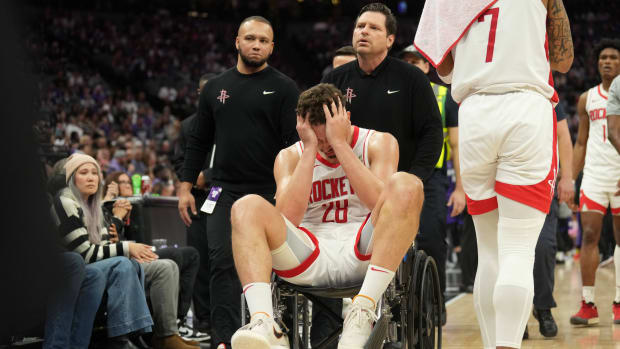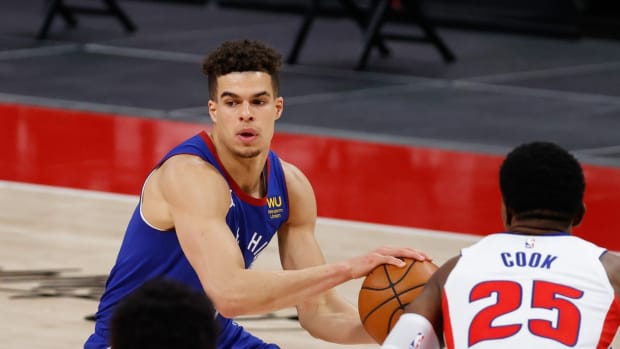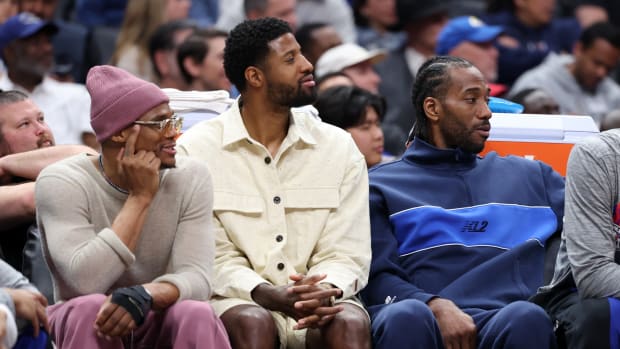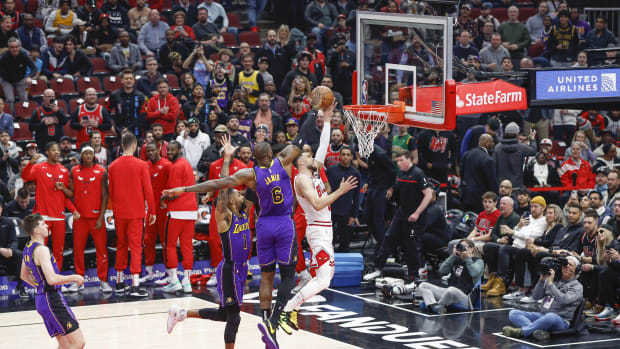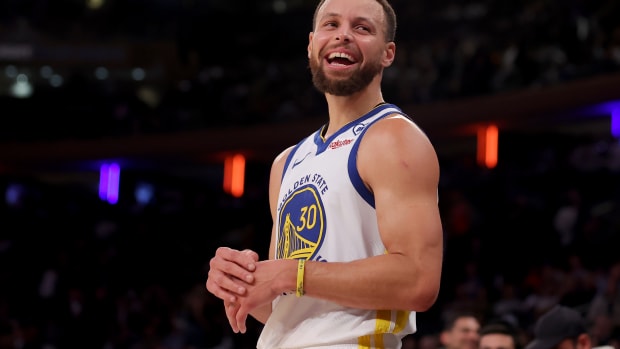Jose Calderon among players hoping to make old opportunities new again
Every player who changed teams this summer has a chance to swell to their new circumstances. The right move—and with it, the right shift in coaching, system, and chemistry—could bring out the best in any star as much as any role player.
The offseason, though, is a reset even for those who didn't relocate. A static situation doesn't typically have the same transformative potential as a complete change in setting might.
Even still, there's room for certain players to adjust their roles or build out their games in ways that make old opportunities new again. Today we turn our attention to that set: Specifically, those improving upon sluggish seasons while keeping with the same team.
Jose Calderon, Knicks
Calderon's best basketball may be behind him, but I'm not quite ready to write off one of the league's most precise shooters and facilitators. Everything went wrong for Calderon last season: The learning curve of the triangle offense was a struggle for some teammates; Carmelo Anthony's injuries robbed the Knicks of their only star; a general lack of talent put New York at a nightly disadvantage; and most relevant of all, Calderon was bothered (and eventually sidelined) by an Achilles injury that compromised his season.
Each of those factors will be addressed in some fashion for the coming season, beginning with Calderon's health. For a player of Calderon's age (he'll turn 34 in September) to battle through a serious injury is never heartening for his future prospects. Yet Calderon expects to be fully healthy for the start of training camp, which should be good enough for a player who has never relied on athletic explosion. An injured Achilles hindered Calderon in subtler ways—not necessarily limiting his ability to get the shots he wanted, but nagging subtly on his lift and accompanying every jumper with a sharp pain.
It came as little surprise, then, that so many of Calderon's pull-up jumpers out of the pick-and-roll and spot-up threes from the week side would come up short. His shooting efficiency plummeted in both regards, robbing Calderon of one of the particular qualities that made him a perfect fit for the triangle. This year should be different. A healthier Calderon stands to benefit greatly from New York's partial rebuild and further acclimation to a motion system. Anthony and Arron Afflalo will be spoon-fed jump-shooting opportunities by Calderon's passing. Robin Lopez and Kristaps Porzingis will have a sharp, experienced pick-and-roll partner who doesn't need to dribble penetrate to create openings for others.
A healthy Calderon makes the Knicks better—not so much so that they might make the playoffs, but enough for his presence and influence to be notable all the same.
Kyle Singler, Thunder
The extended absence of Kevin Durant last season left Oklahoma City disoriented, despite Russell Westbrook's every effort to fill the void. Kyle Singler, who was acquired at the trade deadline as part of the deal that landed Enes Kanter, joined that disarray in midstream. It's hard enough for an NBA player to feel fully comfortable after changing teams, cities, teammates, coaches, and playbooks at the deadline. In this particular case, Singler had to unobtrusively find his place on a team that had little structure or definition beyond Westbrook's place at the apex.
Summer League notebook: Durant free agency stokes Thunder spending
He never seemed fully comfortable. Singler started most of his games for the Thunder and logged around 18 minutes a night—many of them empty. At his best, Singler is swinging the ball, knocking down shots, and defending capably. Last season, that passing was inconsistent as a result of the Thunder's stilted offense, Singler's shot was a constant struggle (his 46.1% true shooting with the Thunder was easily the worst of his career), and defensively he looked more overmatched than usual.
Singler can do better and should this season. The Thunder apparently share in that expectation given that they just re-signed Singler to a five-year, $25 million deal—a clear vote of confidence despite his initial struggles. The transition from Scott Brooks to Billy Donovan leaves much in the air when it comes to the specifics of how the Thunder will play next season. More broadly, though, Singler is a good enough shooter to expect some regression to the mean and a solid enough all-around player to carve out a more meaningful role.
Zach LaVine, Timberwolves
As was noted by Kevin Pelton at ESPN.com, LaVine played a vast majority of his minutes last season as an in-over-his-head rookie point guard. The return of Ricky Rubio and the drafting of Tyus Jones would seem to suggest a little more positional wiggle room in LaVine's future—a development that should bode well for his shot selection. Running LaVine at the point lent itself to possessions like this one:
Taking the ball out of his hands should reorient LaVine's game and deny him his vices. Last season, LaVine rated as a crummy pick-and-roll scorer (in the bottom quarter of the league by efficiency percentile) and shot 28.9% in isolation situations, according to Synergy Sports. He was far more successful in playing off the ball as a spot-up option—a role that made good use of LaVine's clean stroke without the poor balance and challenging timing of a pull-up or step-back.
Give LaVine the benefit of playing alongside Rubio, Karl-Anthony Towns (who made some spectacular passes from the post at the Las Vegas Summer League), and Andrew Wiggins (who assisted LaVine more last season than any other teammate), and I suspect he'll find his way as a complementary scorer.
The goal isn't to deny LaVine completely—merely to better control the situations in which he's called to create. From a developmental standpoint, it would behoove Minnesota to work through LaVine in particular stretches as a means to broaden his game. The priorities within the offense, however, should naturally lean toward more capable creators as a default. LaVine can grow just as well by learning a role of less immediate command.
Jodie Meeks, Pistons
Now that the Pistons are beginning to more closely resemble the Stan Van Gundy model, Meeks should fall into place as an effective complement. To be fair, his 2014-15 season was just fine; Meeks's performance wasn't so far off from his career averages as to be any kind of disaster, even if the 32-win Pistons on the whole were something of a disappointment.
I just think Meeks has an opportunity to be a better shooter on the move than he showed last season. When given a chance to set his feet, Meeks did just fine from two- and three-point range alike. The trouble came when Meeks was run around screens into possessions where he had to catch, turn, and fire up a shot quickly. Meeks isn't quite as nimble as other guards put in that role and, at 6'4", doesn't have the highest release point. Still, the Pistons should now be better able to set up Meeks' jumpers by stringing together more fluid side-to-side action.
This is now a pick-and-roll team built around Andre Drummond and Reggie Jackson, spaced at the four by Ersan Ilyasova and Anthony Tolliver, and flanked on the wings by the likes of Meeks, Kentavious Caldwell-Pope, and Marcus Morris. That lineup structure lends itself to more passing and more concurrent action; now that the Pistons are more of a four-out team, they can run a primary pick-and-roll on one side of the floor and some other screen series for a player like Meeks on the other. It was not a coincidence that Meeks posted 59.3% true shooting (very much in line with his 60.1% mark with the Lakers the season prior) with Drummond and Jackson on the floor to give the offense structure.
Detroit is now getting to the point where its offense can be refined and built out. Quality shooters—who work off of decoys, serve as a pressure release, and can give good sets another actionable layer—tend to be the prime beneficiaries of that development.

































